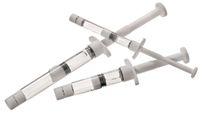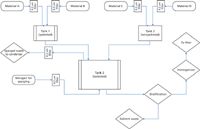Strategies in Parenteral Drug Manufacturing
A technical forum moderated by Patricia Van Arnum
Dual-chamber systems in parenteral drug delivery
Thomas Otto, managing director at Vetter Pharma-Fertigung.
Biologics present a challenge to both the manufacturer and end-user. They usually must be formulated as parenterals. In liquid form, however, they often are unstable because of their complex structure and composition. In that case, they must be manufactured using highly specialized processes, such as lyophilization (i.e., freeze-drying), which nearly eliminates stability issues. Reducing a compound's sensitivity to temperature prolongs its shelf-life, but reconstitution can be cumbersome as it involves multiple steps that can increase the potential for error. Dual-chamber technology provides an effective alternative (see Figure 1 [Dual-chamber technology]) as it combines the lyophilized drug and diluent in a closed system, thereby enabling reconstitution in a few simple steps.

Figure 1: (dual-chamber technology): Example of a dual-chamber syringes for various fill volumes with a tamper-evident closure system. (VETTER)
Traditional versus dual-chamber technology. Traditionally, users receive lyophilized drug product in a vial. To administer, the user meters the diluent into a syringe and adds the diluent to the lyophilized vial. Next, the reconstituted drug is withdrawn from the vial, and after changing the needle, the drug is administered to the patient. This process requires careful measuring of the diluent and the reconstituted drug, manual dexterity, and numerous steps for administration. This process is unwieldy for medical professionals in the clinic and especially for patients and their caregivers who self-administer in nonclinical settings.
Dual-chamber technology is one approach that can be used to resolve these problems in drug administration. The dual chamber is a closed system with the lyophilized drug residing in one chamber and liquid in the other. Before administration, the diluent is pushed through a channel between the two chambers to reconstitute the drug, which can then be injected.
Manufacturing process. Although the dual-chamber system is simple to use, its manufacture is more complex and requires lyophilization of the drug within the delivery system. The process begins by washing, siliconizing, and sterilizing the glass barrels, which are then each separated into two chambers by a middle stopper. Liquid drug is filled into the front chamber, and a closure is set in place. The drug is lyophilized to produce a stable lyocake after which the closure is sealed. The second chamber is filled with diluent, and the end stopper is put in place.
The primary packaging components, such as glass barrels, stoppers, and closure systems, must be carefully selected to withstand the manufacturing process to prevent adversely affecting the drug: During lyophilization, temperatures can reach as low as –60 °C under vacuum. Moreover, compounds can interact with the silicone and rubber formulations, so the drug must be precisely matched with the container components.
Benefits. The dual-chamber systems offer several benefits. They increase dosing precision because the drug and diluent are premeasured and sealed. They decrease risk of medication error by eliminating the use of multiple vials and needles. Moreover, because of their simplicity, dual-chamber systems allow patients or their caregivers to administer drugs at home. Dual-chamber syringes are used with single-dose drugs, but if medication is delivered in multiple doses, a dual-chamber cartridge with a pen system can be used. This versatility allows dual-chamber systems to be used in a life-cycle management strategy at initial launch or in later product generations.
Dual-chamber systems reduce overfill requirements. Vials require greater overfill to ensure that enough drug is available to manually draw the drug into a syringe. Because dual-chamber systems are closed and more efficient at dosing, they require less overfill.
Aseptic compounding and processing
Mathew Cherian, PhD, director of One 2 One Global Pharmaceutical Services at Hospira.
Traditional sterile processing entails compounding in a Class C environment, followed by various process steps, culminating in sterile filtration into a Class A environment for filling. Aseptic compounding and processing offer an alternative to the traditional modality when processing highly potent and toxic sterile pharmaceutical products. Aseptic compounding and processing use an equipment train that has been precleaned, connected, hermetically sealed, and sterilized. The entire process is carried out under aseptic conditions. The active principle and excipient(s) are sterile-filtered in suitable solvents. Various process streams may be mixed, including solvent removal, solid-dispersions formation, homogenization, and finally the product filling (see Figure 1 [aseptic compounding]).

Figure 1: (aseptic compounding): An example of an aseptic manufacturing line. (COURTESY OF HOSPIRA)
Aseptic compounding offers the advantage of being able to manufacture sterile products under the cleanest conditions used in the industry. By virtue of sterile filtration into a previously sterilized equipment train, the bioburden is extremely low, and particulate contamination attributed to environment and starting materials are obviated. In addition, no final filtration is necessary. For large-volume parenterals that are required to be terminally sterilized under US regulations, a lower F0 value, a measure of heat input, may be justified (1). This condition is especially helpful if the product is thermolabile.
Manufacturing considerations. Safe use of solvents for various process steps is helped by the hermetically sealed equipment train. Use of flammable and toxic solvents is made possible, including Class C solvents. There is no need to have explosion-proof facilities when handling flammable solvents, such as ethanol. Downstream steps, such as sparging or diafiltration, can be used to remove the solvents to the required level. If dry equipment is needed at one or more stages of the processing, dryness is easily achieved poststerilization by passing sterile filtered air through the equipment while the equipment is still hot. The equipment typically used for aseptic compounding makes it possible to have precise temperature control over the entire process. It also is possible to extend the processing time, when needed, as there is no risk of increased bioburden due to protracted holding and processing time.
Highly potent compounds increasingly are used in the pharmaceutical industry. These compounds may be hormones, cytotoxics, or certain biopharmaceuticals. Aseptic compounding and processing is the safest way to handle these compounds. If oxygen sensitivity of the active principle is of concern, aseptic processing offers a safeguard against oxidative damage during processing since inert gases, such as nitrogen, are safe and easy to use.
Aseptic compounding, however, presents its own challenges. The equipment train is more expensive, and generally speaking, the cleaning process can be more complex. All surfaces, valves, pumps, temperature, and pressure gauges need to be of sanitary design because of the high level of cleanliness required. Cleaning validation is more challenging because it may sometimes be difficult to determine the source of contamination in a long equipment train.
Typically, clean-in-place (CIP) and steam-in-place (SIP) techniques are used. SIP of long equipment trains can be difficult as condensing steam may not reach the entire length of the equipment. Multiple steam entry points may be required. If the process train involves a high pressure homogenizer, an artificial negative for bacterial presence is possible. Media runs are required to validate the aseptic state of the process.
In summary, aseptic compounding and processing are an effective processing method for highly potent and toxic sterile pharmaceutical products, especially when solvents are used in preparing them. No final filtration is necessary, the drug can be protected from oxidation, and it is possible to achieve greater flexibility in process parameters, such as temperature and holding time.
Reference
1. FDA, Guidance for the Industry: Sterile Drug Products Produced by Aseptic Processing–Current Good Manufacturing Practice (Rockville, MD, Sept. 2004).

Drug Solutions Podcast: A Closer Look at mRNA in Oncology and Vaccines
April 30th 2024In this episode fo the Drug Solutions Podcast, etherna’s vice-president of Technology and Innovation, Stefaan De Koker, discusses the merits and challenges of using mRNA as the foundation for therapeutics in oncology as well as for vaccines.